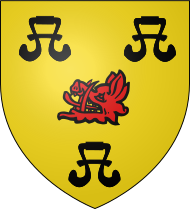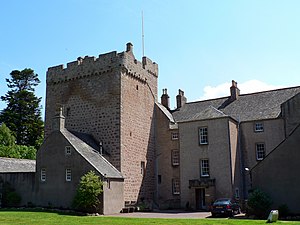Clan Rose
| Clan Rose | |||
|---|---|---|---|
| Ròs[1] | |||
 Crest:A harp upon a chapeau | |||
| Motto | Constant and True | ||
| Profile | |||
| Plant badge | Wild rosemary | ||
| Chief | |||
 | |||
| David Rose | |||
| Chief of Clan Rose, 26thBaron of Kilravock. | |||
| Seat | Kilravock Castle | ||
| |||
| |||
| |||
Clan Rose(Scottish Gaelic:Clann Ròs) is aScottish clanof theScottish Highlands.[2]
History[edit]
Origins of the clan[edit]

The chiefs of the Clan Rose were aNormanfamily.[2]They had no connection to the ancientCelticfamily ofClan Ross.[2]They derive from Ros, nearCaeninNormandyand accompanied the early Norman kings to England. They appear to be connected with two other Norman families; thede Bissetsand thede Boscos.[2]All three of these families disappear from the records ofWiltshireandDorsetwhere they are first known to have settled after the Norman conquest, and they reappear in the mid thirteenth century around the area of theMoray Firth.[2]Elizabeth de Bisset's family owned the lands of Kilravock and she married Andrew de Bosco.[2]Their daughter was Marie, who in around 1290 married Hugo de Ros, whose lands were at Geddes.[2]Hugh's (Hugo's) father had been a witness to the foundation charter ofBeauly Priory,which was erected by Sir John Bisset of Lovat.[2]Hugh and Marie established their home at Kilravock which remained the home of the chief of Clan Rose until 2012.[2]
Wars of Scottish Independence[edit]
During theWars of Scottish Independencethe Barons of Kilravock supported the cause of Scottish Independence.[2]In 1306 they capturedInvernairn CastleforRobert the Bruce.[2]
14th to 15th centuries[edit]
Hugh Rose, fourth of Kilravock, married the daughter of the constable ofUrquhart Castle,Janet Chisholm.[2]This brought the Rose chief extensive lands and made an addition to the chief's coat of arms.[2]A boar's head, as used by the Chisholm family was added to the Rose's shield.[2]In the time of Hugh Rose, fifth of Kilravock all of the family's writs and charters were lost whenElgin Cathedralwas burned byAlexander Stewart, Earl of Buchan(theWolf of Badenoch).[2]The next Baron of Kilravock, John Rose, obtained charters fromJames I of Scotland,theEarl of Rossand theChisholm.[2]
In about 1460 the seventh Baron of Kilravock built the Tower of Kilravock.[2]TheEarls of Rosswere forfeited in 1474 and Hugh Rose received a charter dated March 1475 under theGreat Seal of Scotland.[2]TheClan Mackintoshlater seized the tower in 1482, however they soon surrendered it.[2]
Hugh Rose of Kilravock had expected to marry Murial Calder, daughter of the chief ofClan Calderwho was seated atCawdor Castle.[2]However she was carried off by theClan Campbelland Cawdor Castle has belonged to theClan Campbell of Cawdorever since.[2]
16th century and Anglo-Scottish Wars[edit]
Hugh Rose of Kilravock, the tenth Laird was known as theBlack Baron,however he was in fact an extremely accomplished man.[2]Mary, Queen of Scotsstayed atKilravock Castleand afterwards wrote to him as her trusted friend.[2]The queen's son,James VI of Scotlandvisited Kilravock and it is said that he treated the baron like a father.[2]
17th century and Civil War[edit]

The Rose family had supported theScottish Reformation.However, they later opposed the religious politics ofCharles I of Englandand signed theNational Covenant.[2]The thirteenth Baron of Kilravock led the Clan Rose againstJames Graham, 1st Marquis of Montroseat theBattle of Auldearnin 1645.[2]Later, however, after the king had been handed over to Parliament by the Scottish army, Rose led a regiment of dragoons as part of theDuke of Hamilton's regiment, which planned to rescue the king.[2]
18th century and Jacobite Uprisings[edit]

When theJacobite rising of 1715broke out the Roses declared for the British government.[2]Aurthur Rose was killed leading a detachment of the Clan Rose in seizingInvernessback from the Jacobites ofClan Mackenzie.[2][3]See:Siege of Inverness (1715).General Wade's report on the Highlands in 1724, estimated the clan strength at 300 men.[4]
During theJacobite rising of 1745the Baron of Kilravock entertained the Jacobite leaderCharles Edward Stuartat Kilravock Castle.[2]At the same timePrince William, Duke of Cumberlandoccupied the Rose's town house inNairn.[2]After the Jacobite rising of 1745, the chief's daughter, Anne Rose marriedSir Harry Munro, 7th Baronetwho was the chief of theClan Munro.[5]
Castle[edit]
In 1460 the presentKilravock Castlewas built on the banks of theRiver Nairn.The 25th generation of Rose to live at the castle, Anna Elizabeth Guillemard Rose, signed the estate over to aChristiangroup in 1984[6]who now run the castle as a conference centre.
Clan Chief[edit]

In June 2013, The Lord Lyon recognised David Rose[7]as the Chief of Clan Rose and the 26th Baron of Kilravock. David was preceded by his maternal aunt, Anna Elizabeth Guillemard Rose, 25th of Kilravock who died in Nairn on 9 December 2012, aged 88 years. David Rose is the first Chief of Clan Rose and Baron Kilravock not to reside at Kilravock since 1460.
Clan Rose family tree[edit]
- Hugh Rose of Geddes and 1st of Kilravock, 1st Clan Chief of Clan Rose (died 1306)
- Sir William Rose of Geddes and 2nd of Kilravock, 2nd Clan Chief of Clan Rose (died 1333)
- Hugh Rose, 3rd of Kilravock, 3rd Clan Chief of Clan Rose
- Hugh Rose, 4th of Kilravock, 4th Clan Chief of Clan Rose
- Hugh Rose, 5th of Kilravock, 5th Clan Chief of Clan Rose (died 1420)
- John Rose, 6th of Kilravock, 6th Clan Chief of Clan Rose (died 1454)
- Hugh Rose, 7th of Kilravock, 7th Clan Chief of Clan Rose (died 1494)
- Hugh Rose, 8th of Kilravock, 8th Clan Chief of Clan Rose (died 1517)
- Hugh Rose, 9th of Kilravock, 9th Clan Chief of Clan Rose (died 1544)
- Hugh Rose, 10th of Kilravock, 10th Clan Chief of Clan Rose (died 1597)
- William Rose, 11th of Kilravock, 11th Clan Chief of Clan Rose (died 1611)
- Hugh Rose, 12th of Kilravock, 12th Clan Chief of Clan Rose (died 1643)
- Hugh Rose, 13th of Kilravock, 13th Clan Chief of Clan Rose (died 1649)
- Hugh Rose, 14th of Kilravock, 14th Clan Chief of Clan Rose (died 1687)
- Hugh Rose, 15th of Kilravock,15th Clan Chief of Clan Rose (died 1732), one of theScottish representatives to the first Parliament of Great Britain
- Hugh Rose, 16th of Kilravock,16th Clan Chief of Clan Rose (died 1755), MP forRoss-shire (UK Parliament constituency)
- Hugh Rose, 17th of Kilravock, 17th Clan Chief of Clan Rose (died 1772)
- Hugh Rose, 18th of Kilravock, 18th Clan Chief of Clan Rose (died 1782)
- Elizabeth Rose, 19th of Kilravock, 19th Clan Chief of Clan Rose(died 1815)
- Hugh Rose, 20th of Kilravock,20th Clan Chief of Clan Rose (died 1827), MP forNairnshire (UK Parliament constituency)
- Hugh Rose, 21st of Kilravock, 21st Clan Chief of Clan Rose (died 1847)
- John Rose, 22nd of Kilravock, 22nd Clan Chief of Clan Rose (died 1854)
- James Rose, 23rd of Kilravock,23rd Clan Chief of Clan Rose (died 1909)
- Hugh Rose, 24th of Kilravock,24th Clan Chief of Clan Rose (died 1946)
- Anna Rose, 25th of Kilravock, 25th Clan Chief of Clan Rose (died )
- Madeleine Rose, married Hugh Heriot Baird
- David Baird Rose, 26th of Kilravock, 26th Clan Chief of Clan Rose (incumbent)
- Hugh Rose, 24th of Kilravock,24th Clan Chief of Clan Rose (died 1946)
- Hugh Rose, 20th of Kilravock,20th Clan Chief of Clan Rose (died 1827), MP forNairnshire (UK Parliament constituency)
- John Rose
- John Rose (died 1836)
- William Rose (died 1877)
- Sir John Rose, 1st Baronet(died 1888)
- Sir William Rose, 2nd Baronet(died 1902)
- Sir Cyril Rose, 3rd Baronet (died 1915)
- Sir Francis Rose, 4th Baronet(died 1979 and succeeded bySir Julian Rose, 5th and 4th Baronet)
- Sir Cyril Rose, 3rd Baronet (died 1915)
- Sir Charles Rose, 1st Baronet(died 1913)
- Sir Frank Rose, 2nd Baronet (died 1914)
- Sir Charles Rose, 3rd Baronet (died 1966)
- Sir Julian Rose, 5th and 4th Baronet(incumbent)
- Sir Charles Rose, 3rd Baronet (died 1966)
- Sir Frank Rose, 2nd Baronet (died 1914)
- Sir William Rose, 2nd Baronet(died 1902)
- Sir John Rose, 1st Baronet(died 1888)
- William Rose (died 1877)
- William Rose of Coulmony (died 1780)
- William Rose, Younger of Coulmony (died 1855)
- Philip Rose of North Cliff House (died 1880)
- William Rose, Younger of Coulmony (died 1855)
- John Rose (died 1836)
- Hugh Rose, 17th of Kilravock, 17th Clan Chief of Clan Rose (died 1772)
- Hugh Rose, 16th of Kilravock,16th Clan Chief of Clan Rose (died 1755), MP forRoss-shire (UK Parliament constituency)
- Hugh Rose, 15th of Kilravock,15th Clan Chief of Clan Rose (died 1732), one of theScottish representatives to the first Parliament of Great Britain
- Hugh Rose, 14th of Kilravock, 14th Clan Chief of Clan Rose (died 1687)
- Hugh Rose, 13th of Kilravock, 13th Clan Chief of Clan Rose (died 1649)
- David Rose, 1st of Earlsmill (died 1669)
- Alexander Rose (died 1725)
- Reverend David Rose of Lethnot (died 1758)
- The Rt. Hon.George Rose,MPforChristchurch(died 1758)
- Sir George Rose(died 1851)
- Charles Rose(died 1835)
- MajorGeorge Rose(died 1855)
- Field MarshalHugh Rose, 1st Baron Strathnairn(died 1885)
- Sir William Rose(died 1885)
- William Stewart Rose(died 1843)
- Sir George Rose(died 1851)
- The Rt. Hon.George Rose,MPforChristchurch(died 1758)
- Reverend David Rose of Lethnot (died 1758)
- Alexander Rose (died 1725)
- Hugh Rose, 12th of Kilravock, 12th Clan Chief of Clan Rose (died 1643)
- William Rose, 11th of Kilravock, 11th Clan Chief of Clan Rose (died 1611)
- Hugh Rose, 10th of Kilravock, 10th Clan Chief of Clan Rose (died 1597)
- Hugh Rose, 9th of Kilravock, 9th Clan Chief of Clan Rose (died 1544)
- Hugh Rose, 8th of Kilravock, 8th Clan Chief of Clan Rose (died 1517)
- Hugh Rose, 7th of Kilravock, 7th Clan Chief of Clan Rose (died 1494)
- John Rose, 6th of Kilravock, 6th Clan Chief of Clan Rose (died 1454)
- Hugh Rose, 5th of Kilravock, 5th Clan Chief of Clan Rose (died 1420)
- Hugh Rose, 4th of Kilravock, 4th Clan Chief of Clan Rose
- Hugh Rose, 3rd of Kilravock, 3rd Clan Chief of Clan Rose
- Sir William Rose of Geddes and 2nd of Kilravock, 2nd Clan Chief of Clan Rose (died 1333)
See also[edit]
References[edit]
- ^Clan Rose Profilescotclans. Retrieved 15 November 2014.
- ^abcdefghijklmnopqrstuvwxyzaaabacadaeWay, George of Plean;Squire, Romilly of Rubislaw(1994).Collins Scottish Clan & Family Encyclopedia.Glasgow:HarperCollins(for theStanding Council of Scottish Chiefs). pp. 306–307.ISBN0-00-470547-5.
- ^Mackenzie, Alexander. History of the Frasers of Lovat, with genealogies of the principal families of the name: to which is added those of Dunballoch and Phopachy. Pages 337 - 341.
- ^Johnston, Thomas Brumby;Robertson, James Alexander;Dickson, William Kirk(1899). "General Wade's Report".Historical Geography of the Clans of Scotland.EdinburghandLondon:W. & A.K. Johnston.p.26.Retrieved16 February2020.
- ^Mackenzie, Alexander (1898). History of the Munros of Fowlis with genealogies of the principal families of the name: to which are added those of Le xing ton and New England. Inverness: A. & W. Mackenzie.
- ^"History - Kilravock Castle".kilravock.Retrieved13 April2018.
- ^"2013 Seaside Highland Games".clanrose.org.Retrieved13 April2018.
- ^Mosley, Charles (2003).Burke's Peerage, 2003; Volume 3.London, England: Burke's Peerage Ltd. p. 3391-95.
- ^Rose, Hugh; Shaw, Lachlan (1848).A Genealogical Deduction of the Family of Rose of Kilravock: With Illustrative Documents from the Family Papers, and Notes.Creative Media Partners, LLC.ISBN9781293945957.
{{cite book}}:CS1 maint: multiple names: authors list (link)
External links and sources[edit]
- https:// clanroseinternational.org/Official site endorsed by Clan Chief David 26th of Kilravock
- Clan Rose of Canada
- Clan Rose@ElectricScotland
- Clan Rose at ScotClans
- Archives catalogue for theHugh Rose (of Kilravock) (1863–1946) Collection,The Black Watch Castle & Museum, Perth, Scotland.
